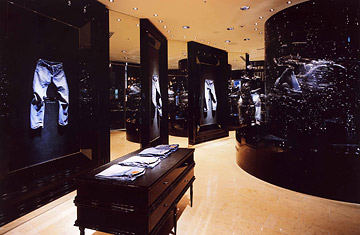
Inside Heddie Lovu's boutique in Tokyo's Omotesando Hills shopping complex.
"If given a thousand dollars, a young Japanese consumer wouldn't spend it on a big, brand-name item. They would go for quality stuff with no logo," says Masaaki Homma, 37, the designer of Mastermind Japan, a pioneer of what's known in Tokyo as "street luxury," a combination of street fashion and traditional Japanese craftsmanship.
"Young connoisseurs are not swayed by prevailing media trends," he says. "They evaluate goods rather coolly." Indeed, Homma is part of a growing population of young Japanese designers and consumers who value luxury over look-at-me logos.
"There will always be people who love a logo," says Jason Lee Coates, a Tokyo-based "cool" hunter and sales and marketing director of H3O, a fashion-p.r. company. "Except now people are starting to learn that luxury and status don't always need a big flashy symbol." Appealing to this younger generation, local lines such as Heddie Lovu denim and Kenji Ikeda bags are looking to European brands like Bottega Veneta and Herms as examples of luxury houses that shun logos.
Homma launched Mastermind Japan in 1997 with a collection featuring skull motifs—a signature that became popular among Tokyo's street-fashion tribes. But it was the extraordinary caliber of the fabrics used in Homma's meticulously constructed designs that ultimately caught the eye of fans like Karl Lagerfeld. Researching state-of-the-art techniques, Homma has developed distinctive materials such as laser-printed leather and waterproof silk (which is traditionally used for kimonos).
"Homma has a great eye. He recognizes the finest quality," says Masanori Nishikawa, a knitwear-factory owner and artisan who teaches at Tokyo's prestigious Bunka Fashion College. "He has the guts to try something challenging. So if I propose new techniques, he identifies with them immediately and adopts them."
Although Homma now shows his collection in Paris and his clothes are sold at 35 local and 20 overseas shops, he didn't always find it easy to get his message across. When he started out, local buyers and journalists dismissed him as an unknown. It wasn't until Homma showed his collection in Paris in 2001 that he began to attract the attention of several buyers. "It was in the midst of a Uniqlo boom in Japan, when people were wondering how to look cool in Uniqlo's $8 pieces," recalls Homma. "My stuff was already said to be expensive, so I decided to improve on it and go all the way to make really high-quality clothes." In 2002 a buyer from Maxfield in Los Angeles took note and ordered 20 pieces, including a $2,000 skull-patterned hand-knit cashmere sweater. Celebrities like Tom Cruise and Justin Timberlake began wearing Mastermind Japan, and sales of Homma's clothes took off.